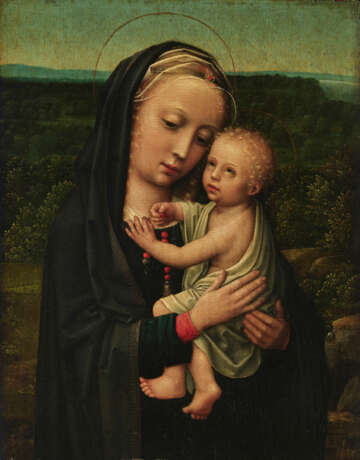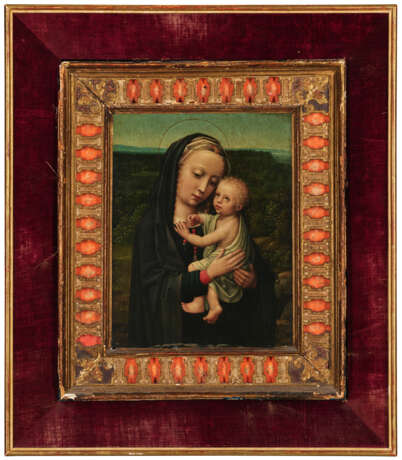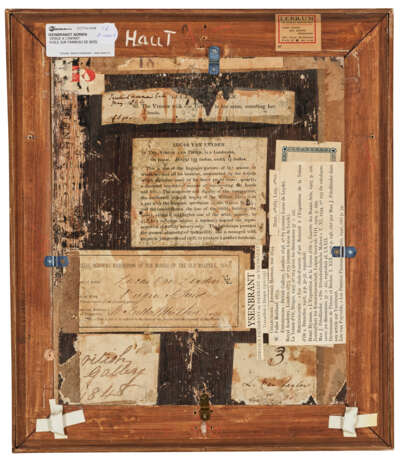ID 1437181
Лот 6 | ADRIAEN ISENBRANDT (BRUGES VERS 1480/1490-1551)
Оценочная стоимость
€ 200 000 – 300 000
Vierge à l'Enfant dans un paysage
porte un monogramme 'VL' ([le V et le L imbriqués] en bas, à droite)
huile sur panneau
28,5 x 22 cm (11 ¼ x 8 2/3 in.)
Provenance
Jeremiah Harman (1763-1844), Higham House, Woodford, Londres ; sa vente après décès, Christie's, Londres, 17 mai 1844 et jours suivants, lot 66 (comme Lucas de Leyde) ;
Acquis au cours de celle-ci par Daniel[l/e].
Edward Harman (vers 1776-1860), Clay Hill, Enfield, Angleterre ; sa vente, Christie and Manson, Londres, 27 mai-29 mai 1847, lot 386 (comme Lucas de Leyde) ;
Acquis au cours de celle-ci par Emery.
William Fuller Maitland (1813-1876), Stansted Hall, Angleterre, depuis au moins 1848 et jusqu'au moins 1873 (comme Lucas de Leyde - selon les catalogues d'exposition de 1848 et de 1873, voir infra).
Chez Robert Langton Douglas (1864-1951), Londres (selon une inscription dans les archives photographiques de Max Friedlander 'Fuller Maitland / Douglas / Schloss' [RKD — Nederlands Instituut voor Kunstgeschiedenis]).
Adolphe Schloss (1842-1910), Paris, depuis au moins 1907 (comme Adriaen Isenbrandt - selon le catalogue d'exposition de 1907, voir infra) ;
Puis par héritage à son épouse, Lucie Schloss, née Haas (1858-1938), Paris, entre 1911 et 1938 ;
Puis par descendance aux héritiers Schloss, Paris, en 1938 ;
Transféré par les héritiers Schloss au château du Chambon, Laguenne (Corrèze) [dépôt de la banque néerlandaise Jordaan], les 19-20 août 1939 ;
Saisi par des fonctionnaires du régime de Vichy et des agents allemands le 16 avril 1943 et transféré à la Banque de France, Limoges, le 24 avril 1943 ;
Transféré au Commissariat général aux questions juives (CGQJ), Paris, les 10-11 août 1943 (inv. Schloss 122) ;
Approprié préventivement par les responsables du musée du Louvre et entreposé dans un dépôt à Sourches (Sarthe), le 20 août 1943 ;
Restitué aux héritiers Schloss, en juillet 1946 ; leur deuxième vente [Collection de feu M. Adolphe Schloss], galerie Charpentier, Paris, 5 décembre 1951, (Mes Rheims & Baudoin), lot 62 (comme Adriaen Isenbrandt) ;
Très probablement acquis au cours de celle-ci par la famille de l'actuel propriétaire.
Literature
H. Hymans, 'L'exposition de la Toison d'Or', Gazette des Beaux-Arts, 1907, 49e année, 3e période, XXXVIII, p. 216.
'Zentralblatt für Kunstwissenschaft', Leipzig fascicule, 1909, VIII, p. 259 (selon le catalogue de vente de 1951, voir supra).
M. J. Friedländer in U. Thieme, F. Becker, Allgemeines Lexikon der Bildenden Künstler von der Antike bis zur Gegenwart, Leipzig, 1926, XIX, p. 246 (comme Adriaen Isenbrandt).
A. Graves, A Century of Loan Exhibitions 1813-1912, Londres, 1913, II, p. 696.
L. van Puyvelde, Les primitifs flamands, Paris, 1941, p. 34 (comme Adriaen Isenbrandt).
M. J. Friedländer, Early Netherlandish Painting. The Antwerp Mannerists. Adriaen Ysenbrant, New York-Washington, 1974, XI, (réédition Berlin, 1933, p. 137, n°193 [avec des dimensions erronées de 37 x 21 cm], reproduit en noir et blanc pl. LXXII), p. 89, n°193 (comme Adriaen Isenbrandt, non localisé), reproduit en noir et blanc pl. 142.
Exhibited
Londres, British Institution, Pictures by Italian, Spanish, Flemish, Dutch, French and English Masters, juin 1848, n°85 (comme Lucas de Leyde).
Londres, Royal Academy of Arts, Exhibition of the Works of the Old Masters Associated with Works of Deceased Masters of the British School, Paintings in Oil and Water-Colours, and Sculpture, 1873, n°179 (comme Lucas de Leyde).
Bruges, Provinciaal Hof, L'exposition de la Toison d'or et de l'art néerlandais sous les ducs de Bourgogne, 30 juin-7 octobre 1907, n°214 (comme Adriaen Isenbrandt - avec des dimensions erronées de 37 x 21 cm).
Further details
ADRIAEN ISENBRANDT (CIRCA 1480/1490-1551), VIRGIN AND CHILD IN A LANDSCAPE, OIL ON PANEL, BEARS A MONOGRAM (LOWER RIGHT)
The life and work of Adriaen Isenbrandt (c.1485-1551) remain shrouded in mystery. Born in Antwerp around 1485, he was admitted as a Freemason to the Guild of Saint Luke in Bruges in 1510. The tradition of the Bruges school, and in particular of one of its last and principal representatives, Gerard David (1460-1583), marks the painter's style, even if his pictorial style goes beyond it by borrowing the codes of Antwerp Mannerism. In this case, the painter seems to have been inspired by David's Rest on the Flight into Egypt (National Gallery of Art, Washington, inv. 1937.1.43) for the Virgin's face, gently inclined towards the Child. This very popular composition was taken up and adapted several times, both by David himself and by his pupils. The distribution of models between the Bruges workshops enabled painters to reproduce successful compositions, thus responding to a growing demand on the part of private individuals for paintings for private devotion.
The small, intimate format of this Marian image suggests that it was a devotional painting intended for private piety. As an image to which the viewer would return again and again, the devotional scope of the iconography is carefully designed to allow multiple levels of interpretation, offering a continuous source of meditation and prayer. Take, for example, the tender gesture of the Infant Jesus playing with the coral bead amulet. While the practice of having young children wear branches or beads of coral is rooted in pagan belief, it also became part of the Christian tradition. As well as helping young children to teethe, coral was said to have virtues such as protecting them from haemorrhaging, convulsions and fever attacks. This innocent, playful gesture serves to underline the child's humanity, as does his gaze, turned towards his mother. Similarly, the setting of this intimate scene in the middle of nature, with the wooded, gently undulating landscape, is not an insignificant choice. The beauty of nature was seen as a source of wonder at God's creation. In addition, such a view allowed believers to imagine the scene before them, an exercise widely promoted by popular devotional literature such as the Meditations on the Life of Christ by the Pseudo-Bonaventure or The Life of Jesus Christ by Ludolphe the Carthusian (c.1300-1377 or 1378), which consisted in inviting readers to place themselves in scenes from the life of Christ in order to better experience, identify and empathise with the biblical figures.
| Категория аукционного дома: | Картины, Акварели, Рисунки, Картины |
|---|
| Категория аукционного дома: | Картины, Акварели, Рисунки, Картины |
|---|
| Адрес торгов |
CHRISTIE'S 8 King Street, St. James's SW1Y 6QT London Великобритания | |
|---|---|---|
| Предосмотр |
| |
| Телефон | +44 (0)20 7839 9060 | |
| Комиссия | see on Website | |
| Условия использования | Условия использования |






